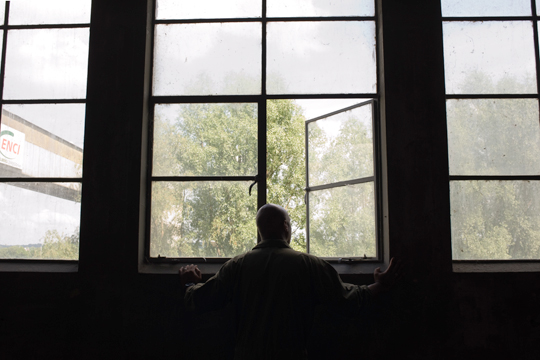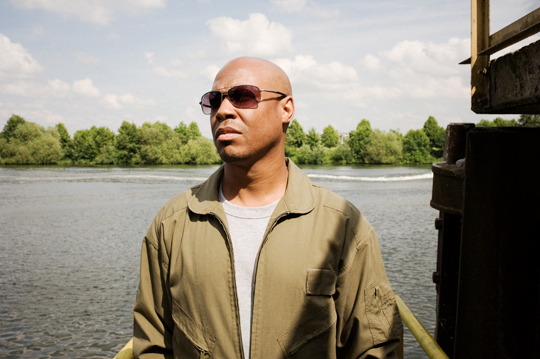Thousands of Miles and Decades Removed from the City’s Glory Days, Robert Hood Takes the Spirit of Detroit into the Future
When Robert Hood came of age in Detroit, radical change was in the air. People, […]

Thousands of Miles and Decades Removed from the City’s Glory Days, Robert Hood Takes the Spirit of Detroit into the Future
When Robert Hood came of age in Detroit, radical change was in the air. People, […]

When Robert Hood came of age in Detroit, radical change was in the air. People, ideas, and product were on the move. The 1960s and ’70s were marked by political and cultural swings, growing black empowerment, and abandonment by second- and third-generation ethnic whites on one hand; urban guerrilla creativity busting out across the racial spectrum on the other.
The auto industry lorded over the economic landscape, blotting out whatever there was of the mid-north sun, which came instead as music played, sung, and produced by Motown: the great equalizer.
“Everyone listened to it on the radio, which didn’t segregate between black or white, rich or poor,” says Hood, who was born in 1965, around the time that AM stations like Windsor’s CKLW (Detroit’s Canadian neighbor to the South) and Dearborn’s WKNR were playing everything: The Miracles and The Marvelettes, Mitch Ryder and Bob Seger, The Beatles and The Stones. “It was just music, man. Good music, that we were exposed to day and night. But it was Motown that was the sound of the inner city for me.”

Later he got his inspiration from stations WGPR and WJLB—where crypto-on-air personality Charles Johnson (a.k.a. The Electrifying Mojo) recombined pop rhythms from all over the world, mixing them with Detroit soul fire to mold the raw foundation for techno.
“I can’t tell you enough times, and I know this story has been told before, but Detroit radio is what influenced all of us to do our own thing,” Hood says. “We might not have known what we were doing exactly, but Mojo helped expose us to new worlds. He was like our teacher, telling us ‘there are no boundaries.'”
And pure, raw techno with no boundaries is what Robert Hood is all about. Dubbing his own reductive groove community “the minimal nation” a solid 20 years ago, his story is one of the most enduring in over a quarter century of electronic music history. He was one third of the original Underground Resistance with Mike Banks and Jeff Mills (tip: check 1991’s fierce X-101 LP), then broke off to nurture his own independent career as producer and DJ. He moved to New York, started his own M-Plant label, recorded and released tracks on Mills’ Axis and Berlin’s Tresor imprints, and then cruised into a new century where the next generation of minimal was waiting for him. But his heart and soul remained in old Detroit. Still does, in fact.
Underground Resistance – “Sonic Destroyer”
From the early-to-late 1970s, Hood heard jazz, blues, new wave, glam rock, synth-pop, disco, embryonic rap, and hip-hop in interstellar overdrive—just by tuning his radio dial. His favorite Detroit artists were Marvin Gaye and The Temptations, but it was another mammoth track of the era that grabbed his ear and never let go: Isaac Hayes’ “Theme From Shaft.”
“From the first time I heard it, I was just overwhelmed by the way the sounds were introduced. The strings, the horns, drums, and funky guitar riff,” he says. “Then his voice rolls in and off you go. Man! To me, that was the start of thinking in terms of ‘minimal.’ Just taking basic elements and making a track work by using less, not more.”
Though based in Alabama since 2004, Hood still describes himself as a “black kid from Detroit,” who grew up on the city’s sprawling Northwest side populated with auto workers, machinists, dye makers, handymen, city workers, merchants, playground ballers—not to mention a bunch of kids fooling around with electronic music-making hardware.
Once a residential destination for working-class families, Hood’s neighborhood as a teenager was an urban bedroom community with good shopping options and public schools holding their own. Tour the area on foot now and you see a Detroit that appears suspended in that era. Single-family brick houses built as early as the 1920s through the 1940s still line the long blocks. But some of the homes are gone, with the industrial shops and commercial strips laid to waste. One of America’s great avenues, Grand River, dissects Northwest Detroit as it links downtown with suburbia. Some of it in intact, other parts charred and being readied for federally subsidized demolition.

It is along this diagonal spoke that fellow electronic dance pioneers Kelli Hand, Mike Huckaby, and Anthony “Shake” Shakir lived (Hand, Huckaby, Shakir, and Hood all attended nearby Cooley High School), close enough to walk or ride a bike to Cliff Thomas’ influential Buy-Rite Records. The shop on 7 Mile Road did on the ground what radio did for local air space: filled it with imports by Kraftwerk, Depeche Mode, and Heaven 17; US indie 12s by The B-52’s, Prince, and Devo; emerging deep Detroit sides by Cybotron and Model 500, Rhythim is Rhythim and Inner City.
Add to that the spaced-out rock-soul hybrids of George Clinton’s P-Funk dynasty and acid-house mayhem by way of Chicago, and there you have it: the blueprint for the shapeshifting of things to come.
“Detroit was a hip place, very culturally avant garde,” he says. “It was a rough place, but musically sophisticated. I think that kind of pressure that came from both sides helped make it unique. We had the radio, we had the records. We felt something different going on around us and we seized on it.”
Hood says he began experimenting with his “theory of reducing dance music to an essence” after he puzzled over what first-generation Detroit techno artists like Juan Atkins, Derrick May, Kevin Saunderson, and Eddie Fowlkes were producing.
“I couldn’t make it out, to be honest with you,” Hood says. “It was a new, exciting sound, but it had a vibe you had to catch up to, like it came out of the future or from another galaxy. I tried to break it down so I could bring out the most important element: the African drum.”
It might be a slightly revisionist view to suggest that Detroit techno was the soundtrack for post-industrial decline and social breakdown of the world’s most prolific factory town. Transportation to another place via danceable electronic waveforms threatens to become cliché the more the myth circulates around the globe. But hearing Hood talk about it adds a bold truth to the mythology.

“As I was growing up, the city started to empty out, the present was a place where you just had to try to survive,” he says. “The Reagan era was the height of the crack era in Detroit. The ’80s were a destructive period, time stood still except for the violence, the city stopped functioning. If you wanted to get out of that, you had to dig down and find something in the subconscious, something deeper and more beautiful. That’s how we first started traveling—in our own minds.”
Set free by repetitive beats, fleshed out with militant rhetoric from the UR camp—not so militant as it turned out, more about rebuilding community life and discipline amid rising poverty, decay, and desolation in the city—Hood challenged the future by staying lean and mean in his music. Go into his catalog that has remained consistently roots- and soul-oriented after well over 100 original tracks, remixes, mixtapes and mixed CDs, podcasts, and bootlegged live sessions, and you will detect a steady hand at the controls.
Hood’s genius is stretching a single, brilliant idea over two decades of productive work. Put on a classic M-Plant track from Minimal Nation (originally issued in 1994, re-released last year) like “Museum” or “One Touch” and contrast it with new material on this summer’s apocalyptic Omega, and you’ll find its structure and texture eerily alike.
But thematically, a shift is apparent. The work is based on 1971 science-fiction cult film The Omega Man, which stars Charlton Heston as a scientist who survives a global plague after biological warfare kills off most the planet’s human population. Those that survive have become mutants who want to kill the scientist, who represents a failed age of technology gone amok. There are biblical allusions strewn throughout the film, which includes a symbolic crucifixion at its climax.

Hood says he’s alway been enamored with the film, and how it presents both sides of a grim scenario for humanity. He can just as easily put himself in the position of the scientist/hero as he can the “villains” who seek a more “pure and spiritual” existence, however misguided.
“I saw the movie when I was a kid, and later I related to the main character because he was alone in the world—and producing techno can be an interior, lonely life,” he says. “But now, I see it in much deeper spiritual terms. Like this is part of a prophecy we’re seeing realized almost every day.”
How so?
“There is such universal pain in the world, destruction, and chaos that I fear we’re reaching the end of our time on this planet,” he says. “I wanted to make an album that reflected an evolution of how I’ve come to see things like that spiritually. This isn’t like a sudden revelation, but something I’ve been thinking about and acting on as an artist since the late 1990s.”
Hood lives close to the Gulf of Mexico and says he was profoundly disturbed by the April oil spill that history may record as one of the worst man-made ecological disasters ever. He is saddened by conflicts in Iraq and Afghanistan, and the current quality of modern life in this country. “We’re so disconnected in how we communicate, by using computers and the internet, we don’t know anybody, really, anymore,” he says. “It’s changed us all. I wanted Omega to reflect a serious tone, not just something made for people to dance to in the club.”
“Alpha”
But dance to it in the club, they will, largely due to Hood’s time-tested and infectious cut-and-run style. After its somber, dare say, dark ambient beginnings with “The Plague (Cleansing Maneuvers),” Hood reaches for his African drum and seduces body and soul on the crushing “Towns That Disappeared Completely,” which recalls UR as much as it does the aqua-electro acid of fellow Detroiters Drexciya. The next track, “Alpha,” is almost entirely constructed from drums and bass vibrations before a simple one-note synthetic symphony rises out of the rumbling low end and hangs out on top for a beautiful finish.
“The Workers of Iniquity” is funk reduced to fat, loopy patterns, and “Are You God?” quickens the pulse by layering drums over more drums, slashing and stabbing with synth lines that actually come close to the wicked rhythm-guitar lead on “Shaft.” The deeper you go, the darker it gets. “The Family Watches” approaches schizoid-paranoid territory. Strange sounds dance around a tight, rolling bass drum, which ultimately gives way to even stranger, almost alien melodies. Pay heed to the killer drum outro. “The Wheels of Escape” also seems possessed of alien-sounding bleeps, which drive the tune forward on the back of multiple percussion.
The final piece, “Omega (End Times),” sounds scarier than it really is, more like a cautionary tale told at 180 BPMs, with thunderclaps, and a bridge made up of a chorus of melodic synths that creates anticipation for the final instrumental surge—a frantic, manic release, before a soothing fade to black.
Hood says Omega is also indirectly a response to the minimal techno scene that broke wide open in the mid-’00s, largely in Europe, leaving bits of sonic residue on the Detroit sound. The bigger influence is on the party experience itself, which turned away from quality to quantity in the form of marathon events seemingly without end.
“What’s missing in all that is the meaning and substance of the music itself,” he says. “Anyone can turn on a laptop now and make a track and call it ‘minimal.’ But to me, that music became overly complicated, which is not what it’s supposed to be about. I’m glad people are enjoying the party, but it’s more than just that. It’s a stripped-down narrative about the soul, from the soul. It’s communication from a higher power.”
Omega
is out now on M-Plant
.

